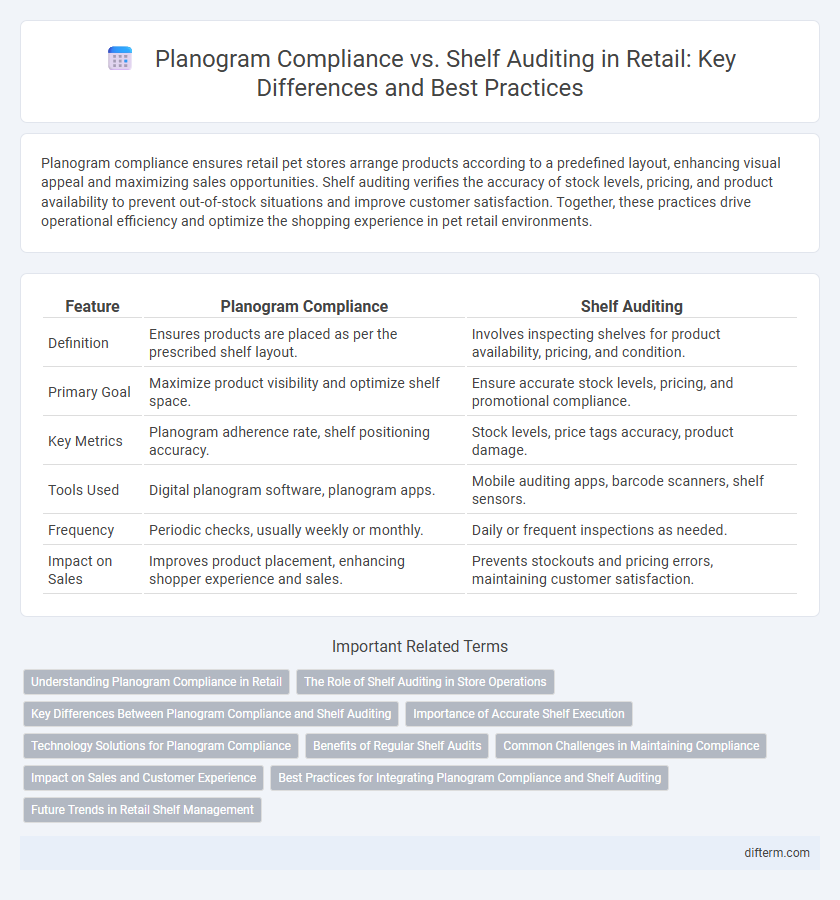Planogram compliance ensures retail pet stores arrange products according to a predefined layout, enhancing visual appeal and maximizing sales opportunities. Shelf auditing verifies the accuracy of stock levels, pricing, and product availability to prevent out-of-stock situations and improve customer satisfaction. Together, these practices drive operational efficiency and optimize the shopping experience in pet retail environments.
Table of Comparison
| Feature | Planogram Compliance | Shelf Auditing |
|---|---|---|
| Definition | Ensures products are placed as per the prescribed shelf layout. | Involves inspecting shelves for product availability, pricing, and condition. |
| Primary Goal | Maximize product visibility and optimize shelf space. | Ensure accurate stock levels, pricing, and promotional compliance. |
| Key Metrics | Planogram adherence rate, shelf positioning accuracy. | Stock levels, price tags accuracy, product damage. |
| Tools Used | Digital planogram software, planogram apps. | Mobile auditing apps, barcode scanners, shelf sensors. |
| Frequency | Periodic checks, usually weekly or monthly. | Daily or frequent inspections as needed. |
| Impact on Sales | Improves product placement, enhancing shopper experience and sales. | Prevents stockouts and pricing errors, maintaining customer satisfaction. |
Understanding Planogram Compliance in Retail
Planogram compliance in retail ensures that products are displayed according to a predetermined layout designed to maximize sales and improve customer experience. Accurate adherence to planograms helps retailers maintain brand consistency, optimize shelf space, and facilitate inventory management. Regular shelf auditing verifies planogram compliance by checking product placement, stock levels, and promotional displays against the retail planogram standards.
The Role of Shelf Auditing in Store Operations
Shelf auditing plays a crucial role in store operations by ensuring product placement accuracy, pricing correctness, and inventory availability, directly impacting sales performance and customer satisfaction. Unlike planogram compliance which primarily focuses on adherence to visual merchandising standards, shelf auditing provides detailed insights into real-time stock levels and product conditions. This comprehensive monitoring enables retailers to identify discrepancies, optimize replenishment processes, and maintain a consistent shopping experience.
Key Differences Between Planogram Compliance and Shelf Auditing
Planogram compliance measures how closely products are arranged according to a predefined store layout to maximize sales and brand consistency, while shelf auditing involves a broader inspection of stock levels, pricing accuracy, and product condition. Planogram compliance specifically focuses on product placement and visual merchandising standards, whereas shelf auditing assesses overall store execution and inventory management. Retailers leverage planogram compliance to ensure marketing strategies are followed, while shelf auditing supports operational efficiency and customer satisfaction by identifying out-of-stock or misplaced products.
Importance of Accurate Shelf Execution
Accurate shelf execution drives higher sales by ensuring products are displayed according to the planogram, maximizing visibility and accessibility to shoppers. Planogram compliance verifies that shelf layouts align with brand strategies, while shelf auditing provides detailed insights into stock levels, pricing, and promotional displays. Together, these processes prevent out-of-stocks and misplacements, enhancing customer experience and operational efficiency in retail environments.
Technology Solutions for Planogram Compliance
Advanced technology solutions for planogram compliance utilize image recognition, AI-powered analytics, and mobile apps to ensure accurate shelf layouts in real time. These tools automate the verification of product placement against planogram standards, reducing human error and increasing store compliance rates. Integration with cloud-based platforms allows centralized monitoring and actionable insights, enhancing retailer decision-making and operational efficiency.
Benefits of Regular Shelf Audits
Regular shelf audits enhance planogram compliance by ensuring accurate product placement, which boosts sales and improves inventory management. These audits identify discrepancies such as out-of-stock items or misplaced products, leading to optimized shelf space and heightened customer satisfaction. Consistent monitoring through shelf auditing empowers retailers to maintain visual merchandising standards and drive operational efficiency.
Common Challenges in Maintaining Compliance
Maintaining planogram compliance and conducting shelf auditing face common challenges such as inconsistent product placement and frequent stockouts, which disrupt the intended visual merchandising strategy. Limited real-time data and manual verification methods increase the risk of errors, making it difficult to ensure shelves consistently reflect planogram standards. Retailers often struggle with employee adherence and training gaps, leading to variations in shelf presentation and impacting overall store performance.
Impact on Sales and Customer Experience
Planogram compliance ensures optimal product placement and inventory levels, directly boosting sales by enhancing product visibility and availability. Shelf auditing complements this by verifying pricing accuracy, product freshness, and shelf conditions, which enriches the customer experience and fosters brand loyalty. Together, these practices drive higher conversion rates and improve overall retail performance.
Best Practices for Integrating Planogram Compliance and Shelf Auditing
Integrating planogram compliance with shelf auditing enhances retail accuracy by ensuring product placement aligns precisely with merchandising standards while real-time shelf audits capture stock levels and display conditions. Utilizing digital shelf auditing tools alongside planogram software promotes consistent data collection, improving corrective actions and shelf replenishment efficiency. Best practices include leveraging AI-driven analytics to detect compliance gaps swiftly and automating reporting workflows for continuous shelf performance optimization.
Future Trends in Retail Shelf Management
Future trends in retail shelf management emphasize the integration of AI-driven planogram compliance tools that enhance real-time monitoring and predictive analytics, optimizing product placement efficiency. Advanced shelf auditing technologies leveraging computer vision and IoT sensors enable automated, accurate inventory tracking and faster identification of compliance gaps. These innovations foster data-driven decisions, improving shelf availability and customer experience while reducing operational costs in retail environments.
Planogram Compliance vs Shelf Auditing Infographic

 difterm.com
difterm.com